Assessment of Wildfire Susceptibility and Wildfire Threats to Ecological Environment and Urban Development Based on GIS and Multi-Source Data: A Case Study of Guilin, China
Abstract
1. Introduction
2. Study Area and Data Overview
2.1. Study Area
2.2. Historical Wildfire Dataset
2.3. Susceptibility Conditioning Factors
2.4. Ecological and Urban Vulnerability Factors
2.4.1. Ecological Vulnerability Factors
2.4.2. Urban Vulnerability Factor
3. Methods
3.1. Multicollinearity Test
3.2. Wildfire Susceptibility Modeling Based on Machine Learning
3.2.1. Logistic Regression (LR)
3.2.2. Artificial Neural Network (ANN)
3.2.3. K-Nearest Neighbor (KNN)
3.2.4. Support Vector Regression (SVR)
3.2.5. Random Forest (RF)
3.2.6. Gradient Boosting Decision Tree (GBDT)
3.2.7. Light Gradient Boosting Machine (LGBM)
3.2.8. eXtreme Gradient Boosting (XGBoost)
3.3. Performance Assessment of Susceptibility Models
3.4. SHapley Additive exPlanations (SHAP) Method
3.5. Ecological and Urban Vulnerability Modeling
3.6. Wildfire Risk Modeling
4. Results
4.1. Wildfire Susceptibility Assessment
4.1.1. Multicollinearity Test Results
4.1.2. Wildfire Susceptibility Map
4.1.3. Model Performance Assessment
4.1.4. Results of SHAP Method
- (1)
- Temperature positively influences the occurrence of wildfires, as higher temperatures result in larger Shapley values and a greater likelihood of wildfire outbreaks. When the temperature exceeds 17.3 °C, the Shapley value is generally greater than 0, indicating higher susceptibility to wildfire disasters.
- (2)
- Except for FLc, LXf, RGc, RGd, RK, and WR soil types, all other soil types have the potential to experience wildfires. Among them, soil types such as Ach and Acf generally have a Shapley value greater than 0, making them more susceptible to wildfire disasters.
- (3)
- Compared to cropland and forest, samples belonging to grassland have the highest Shapley value, making them more susceptible to wildfire disasters.
- (4)
- Overall, the Shapley value of samples increases with an increase in the distance to roads. When the distance to roads is greater than 500 m, the Shapley value is greater than 0, indicating that wildfire disasters in Guilin are more likely to occur in areas far from human activity.
- (5)
- When slope is within the range of [5°, 25°], the Shapley value is greater than 0, indicating a positive effect on the occurrence of wildfires. The mountains within this range of inclination tend to receive more direct sunlight and are more exposed to natural winds, thus causing vegetation to dry out faster and become more combustible.
- (6)
- When wind speed is in the interval of [0 m/s, 0.6 m/s], the Shapley value decreases with the increase in the wind speed, while when the wind speed is greater than 0.6 m/s, the wind speed has a positive impact on the occurrence of wildfires, and the Shapley value of the sample increases with the increase in the wind speed. Moreover, when the wind speed is greater than 0.8 m/s, the Shapley value is generally greater than 0, indicating a higher probability of wildfire disasters.
- (7)
- When the distance to rivers is in the range of (0, 1000 m), the Shapley value of the sample gradually increases and is greater than 0; however, when the distance to rivers is greater than 1000 m, the Shapley value of the sample shows a downward trend, indicating that the area near the river is more prone to wildfire disasters.
- (8)
- There is a non-monotonic relationship between elevation and wildfire. The samples with Shapley value greater than 0 are basically located in the range of (250 m, 1000 m), and the probability of wildfires is high; when the elevation is greater than 1000 m, the possibility of wildfires is reduced.
- (9)
- FVC exerts a positive influence on wildfire occurrence overall. When FVC is in the range of (0.6, 0.8), the Shapley value is greater than 0, and the probability of a wildfire disaster is greater.
- (1)
- For wildfire case 1, soil type, temperature, wind speed, and land use have a significant positive effect, while slope, distance to rivers, distance to urban areas, and elevation have a minor positive effect. Distance to roads has a significant negative effect, and the remaining eight factors contribute a positive effect of 0.05. The final predicted wildfire susceptibility value is 1.018, and it is classified as a wildfire.
- (2)
- For wildfire case 2, soil type, temperature, land use, and slope have a significant positive effect, while solar radiation, FVC, distance to urban areas, and distance to rivers have a minor positive effect. Distance to roads has a significant negative effect, and the remaining eight factors contribute a positive effect of 0.11. The final predicted wildfire susceptibility value is 1.051, and it is classified as a wildfire.
- (3)
- For wildfire case 3, soil type, temperature, wind speed, and land use have a significant positive effect, while slope, elevation, SPI, and distance to urban areas have a minor positive effect. Distance to roads has a significant negative effect, and the remaining eight factors contribute a positive effect of 0.04. The final predicted wildfire susceptibility value is 0.969, and it is classified as a wildfire.
4.2. Wildfire Vulnerability Assessment Considering Ecology and City
4.3. Wildfire Risk Assessment
5. Discussion
5.1. Influence of Sample Confidence on Susceptibility Modeling Results
5.2. Comparison of ML Algorithms and Importance of Conditioning Factors
5.3. Comparison of SHAP Results between the Different Machine Learning Methods
5.4. Assessment Results of Wildfires in Each District and County
6. Conclusions
- (1)
- The ensemble models demonstrated superior predictive accuracy compared to traditional machine learning models. The XGBoost model achieved an AUC of 0.927 and accuracy of 0.863. High-susceptibility areas were found to be distributed in the central, northeast, south, and southwest regions of the study area, covering 41.758% of the entire region and encompassing 74.021% of wildfire samples. This model achieved the most reasonable susceptibility zoning results and the best predictive performance, making it the optimal model.
- (2)
- By using SHAP to interpret the results of the optimal model, the impact and intensity of each factor on wildfire occurrence in the study area were identified. The effects of changes in each factor on wildfire occurrence in the region were also explored. The factors that contributed the most to wildfire occurrence were found to be temperature, soil type, land use, distance to roads, slope, wind speed, distance to rivers, elevation, and FVC.
- (3)
- The ecological environment in the south, west, and northeast of Guilin was found to be vulnerable, while the urban development of Xiufeng, Diecai, Xiangshan, and Qixing districts and their surrounding counties was also found to be vulnerable. Furthermore, the vulnerability model that comprehensively considered ecology and urban development covered more high-vulnerability areas, more accurately divided low-vulnerability and high-vulnerability areas and provided richer detailed information.
- (4)
- From the perspectives of both ecological environment and urban development, potential wildfire risk areas can be identified and evaluated in a more targeted manner. However, a comprehensive evaluation that considers both aspects can provide a more holistic assessment of the wildfire disasters risk to human survival and environmental damage. This approach can enhance the comprehensiveness and accuracy of wildfire risk assessment and serve as a scientific basis for wildfire prevention and control.
Author Contributions
Funding
Data Availability Statement
Conflicts of Interest
References
- Hong, H.; Jaafari, A.; Zenner, E.K. Predicting spatial patterns of wildfire susceptibility in the Huichang County, China: An integrated model to analysis of landscape indicators. Ecol. Indic. 2019, 101, 878–891. [Google Scholar] [CrossRef]
- Sachdeva, S.; Bhatia, T.; Verma, A. GIS-based evolutionary optimized Gradient Boosted Decision Trees for forest fire susceptibility mapping. Nat. Hazards 2018, 92, 1399–1418. [Google Scholar] [CrossRef]
- Pourghasemi, H.R.; Gayen, A.; Lasaponara, R.; Tiefenbacher, J.P. Application of learning vector quantization and different machine learning techniques to assessing forest fire influence factors and spatial modelling. Environ. Res. 2020, 184, 109321. [Google Scholar] [CrossRef] [PubMed]
- Zhang, G.; Wang, M.; Liu, K. Forest fire susceptibility modeling using a convolutional neural network for Yunnan province of China. Int. J. Disaster Risk Sci. 2019, 10, 386–403. [Google Scholar] [CrossRef]
- Gerdzheva, A.A. A comparative analysis of different wildfire risk assessment models (A case study for Smolyan district, Bulgaria). Eur. J. Geogr. 2014, 5, 22–36. [Google Scholar]
- Bui, D.T.; Hoang, N.-D.; Samui, P. Spatial pattern analysis and prediction of forest fire using new machine learning approach of Multivariate Adaptive Regression Splines and Differential Flower Pollination optimization: A case study at Lao Cai province (Viet Nam). J. Environ. Manag. 2019, 237, 476–487. [Google Scholar]
- Achu, A.; Thomas, J.; Aju, C.; Gopinath, G.; Kumar, S.; Reghunath, R. Machine-learning modelling of fire susceptibility in a forest-agriculture mosaic landscape of southern India. Ecol. Inform. 2021, 64, 101348. [Google Scholar] [CrossRef]
- Eskandari, S.; Miesel, J.R. Comparison of the fuzzy AHP method, the spatial correlation method, and the Dong model to predict the fire high-risk areas in Hyrcanian forests of Iran. Geomat. Nat. Hazards Risk 2017, 8, 933–949. [Google Scholar] [CrossRef]
- Al-Fugara, A.k.; Mabdeh, A.N.; Ahmadlou, M.; Pourghasemi, H.R.; Al-Adamat, R.; Pradhan, B.; Al-Shabeeb, A.R. Wildland fire susceptibility mapping using support vector regression and adaptive neuro-fuzzy inference system-based whale optimization algorithm and simulated annealing. ISPRS Int. J. Geo-Inf. 2021, 10, 382. [Google Scholar] [CrossRef]
- Tavakkoli Piralilou, S.; Einali, G.; Ghorbanzadeh, O.; Nachappa, T.G.; Gholamnia, K.; Blaschke, T.; Ghamisi, P. A Google Earth Engine approach for wildfire susceptibility prediction fusion with remote sensing data of different spatial resolutions. Remote Sens. 2022, 14, 672. [Google Scholar] [CrossRef]
- Bui, D.T.; Bui, Q.-T.; Nguyen, Q.-P.; Pradhan, B.; Nampak, H.; Trinh, P.T. A hybrid artificial intelligence approach using GIS-based neural-fuzzy inference system and particle swarm optimization for forest fire susceptibility modeling at a tropical area. Agric. For. Meteorol. 2017, 233, 32–44. [Google Scholar]
- Nur, A.S.; Kim, Y.J.; Lee, J.H.; Lee, C.-W. Spatial Prediction of Wildfire Susceptibility Using Hybrid Machine Learning Models Based on Support Vector Regression in Sydney, Australia. Remote Sens. 2023, 15, 760. [Google Scholar] [CrossRef]
- Nami, M.; Jaafari, A.; Fallah, M.; Nabiuni, S. Spatial prediction of wildfire probability in the Hyrcanian ecoregion using evidential belief function model and GIS. Int. J. Environ. Sci. Technol. 2018, 15, 373–384. [Google Scholar] [CrossRef]
- Salavati, G.; Saniei, E.; Ghaderpour, E.; Hassan, Q.K. Wildfire risk forecasting using weights of evidence and statistical index models. Sustainability 2022, 14, 3881. [Google Scholar] [CrossRef]
- Yuan, X.; Liu, C.; Nie, R.; Yang, Z.; Li, W.; Dai, X.; Cheng, J.; Zhang, J.; Ma, L.; Fu, X. A Comparative Analysis of Certainty Factor-Based Machine Learning Methods for Collapse and Landslide Susceptibility Mapping in Wenchuan County, China. Remote Sens. 2022, 14, 3259. [Google Scholar] [CrossRef]
- Cao, X.; Cui, X.; Yue, M.; Chen, J.; Tanikawa, H.; Ye, Y. Evaluation of wildfire propagation susceptibility in grasslands using burned areas and multivariate logistic regression. Int. J. Remote Sens. 2013, 34, 6679–6700. [Google Scholar] [CrossRef]
- Dutta, R.; Das, A.; Aryal, J. Big data integration shows Australian bush-fire frequency is increasing significantly. R. Soc. Open Sci. 2016, 3, 150241. [Google Scholar] [CrossRef]
- Ghorbanzadeh, O.; Valizadeh Kamran, K.; Blaschke, T.; Aryal, J.; Naboureh, A.; Einali, J.; Bian, J. Spatial prediction of wildfire susceptibility using field survey gps data and machine learning approaches. Fire 2019, 2, 43. [Google Scholar] [CrossRef]
- Arpaci, A.; Malowerschnig, B.; Sass, O.; Vacik, H. Using multi variate data mining techniques for estimating fire susceptibility of Tyrolean forests. Appl. Geogr. 2014, 53, 258–270. [Google Scholar] [CrossRef]
- He, Q.; Jiang, Z.; Wang, M.; Liu, K. Landslide and wildfire susceptibility assessment in southeast asia using ensemble machine learning methods. Remote Sens. 2021, 13, 1572. [Google Scholar] [CrossRef]
- Lan, Y.; Wang, J.; Hu, W.; Kurbanov, E.; Cole, J.; Sha, J.; Jiao, Y.; Zhou, J. Spatial pattern prediction of forest wildfire susceptibility in Central Yunnan Province, China based on multivariate data. Nat. Hazards 2022, 116, 565–586. [Google Scholar] [CrossRef]
- Abdollahi, A.; Pradhan, B. Explainable artificial intelligence (XAI) for interpreting the contributing factors feed into the wildfire susceptibility prediction model. Sci. Total Environ. 2023, 879, 163004. [Google Scholar] [CrossRef] [PubMed]
- Arrieta, A.B.; Díaz-Rodríguez, N.; Del Ser, J.; Bennetot, A.; Tabik, S.; Barbado, A.; García, S.; Gil-López, S.; Molina, D.; Benjamins, R. Explainable Artificial Intelligence (XAI): Concepts, taxonomies, opportunities and challenges toward responsible AI. Inf. Fusion 2020, 58, 82–115. [Google Scholar] [CrossRef]
- Cheng, X.; Wang, J.; Li, H.; Zhang, Y.; Wu, L.; Liu, Y. A method to evaluate task-specific importance of spatio-temporal units based on explainable artificial intelligence. Int. J. Geogr. Inf. Sci. 2021, 35, 2002–2025. [Google Scholar] [CrossRef]
- Lundberg, S.M.; Erion, G.G.; Lee, S.-I. Consistent individualized feature attribution for tree ensembles. arXiv 2018, arXiv:1802.03888. [Google Scholar]
- Dahal, A.; Lombardo, L. Explainable artificial intelligence in geoscience: A glimpse into the future of landslide susceptibility modeling. Comput. Geosci. 2023, 176, 105364. [Google Scholar] [CrossRef]
- Pradhan, B.; Lee, S.; Dikshit, A.; Kim, H. Spatial flood susceptibility mapping using an explainable artificial intelligence (XAI) model. Geosci. Front. 2023, 14, 101625. [Google Scholar] [CrossRef]
- Jena, R.; Pradhan, B.; Gite, S.; Alamri, A.; Park, H.-J. A new method to promptly evaluate spatial earthquake probability mapping using an explainable artificial intelligence (XAI) model. Gondwana Res. 2022; in press. [Google Scholar] [CrossRef]
- Iban, M.C.; Bilgilioglu, S.S. Snow avalanche susceptibility mapping using novel tree-based machine learning algorithms (XGBoost, NGBoost, and LightGBM) with eXplainable Artificial Intelligence (XAI) approach. Stoch. Environ. Res. Risk Assess. 2023, 37, 2243–2270. [Google Scholar] [CrossRef]
- Vaillant, N.M.; Kolden, C.A.; Smith, A.M. Assessing landscape vulnerability to wildfire in the USA. Curr. For. Rep. 2016, 2, 201–213. [Google Scholar] [CrossRef]
- Tang, X.; Machimura, T.; Li, J.; Yu, H.; Liu, W. Evaluating seasonal wildfire susceptibility and wildfire threats to local ecosystems in the largest forested area of China. Earth Future 2022, 10, e2021EF002199. [Google Scholar] [CrossRef]
- Ager, A.A.; Kline, J.D.; Fischer, A.P. Coupling the biophysical and social dimensions of wildfire risk to improve wildfire mitigation planning. Risk Anal. 2015, 35, 1393–1406. [Google Scholar] [CrossRef] [PubMed]
- Lan, Y.; Chen, J.; Yang, Y.; Ling, M.; You, H.; Han, X. Landscape Pattern and Ecological Risk Assessment in Guilin Based on Land Use Change. Int. J. Environ. Res. Public Health 2023, 20, 2045. [Google Scholar] [CrossRef] [PubMed]
- Liu, T.; Ren, C.; Zhang, S.; Yin, A.; Yue, W. Coupling Coordination Analysis of Urban Development and Ecological Environment in Urban Area of Guilin Based on Multi-Source Data. Int. J. Environ. Res. Public Health 2022, 19, 12583. [Google Scholar] [CrossRef]
- Trucchia, A.; Meschi, G.; Fiorucci, P.; Gollini, A.; Negro, D. Defining wildfire susceptibility maps in Italy for understanding seasonal wildfire regimes at the national level. Fire 2022, 5, 30. [Google Scholar] [CrossRef]
- Cao, C.; De Luccia, F.J.; Xiong, X.; Wolfe, R.; Weng, F. Early on-orbit performance of the visible infrared imaging radiometer suite onboard the Suomi National Polar-Orbiting Partnership (S-NPP) satellite. IEEE Trans. Geosci. Remote Sens. 2013, 52, 1142–1156. [Google Scholar] [CrossRef]
- Boschetti, L.; Roy, D.P.; Giglio, L.; Huang, H.; Zubkova, M.; Humber, M.L. Global validation of the collection 6 MODIS burned area product. Remote Sens. Environ. 2019, 235, 111490. [Google Scholar] [CrossRef]
- Giglio, L.; Schroeder, W.; Hall, J.; Justice, C. MODIS Collection 6 Active Fire Product User’s Guide Revision B; University of Maryland: College Park, MD, USA, 2018. [Google Scholar]
- Eskandari, S.; Khoshnevis, M. Evaluating and mapping the fire risk in the forests and rangelands of Sirachal using fuzzy analytic hierarchy process and GIS. For. Res. Dev. 2020, 6, 219–245. [Google Scholar]
- Youssef, A.M.; Pourghasemi, H.R. Landslide susceptibility mapping using machine learning algorithms and comparison of their performance at Abha Basin, Asir Region, Saudi Arabia. Geosci. Front. 2021, 12, 639–655. [Google Scholar] [CrossRef]
- Fang, L.; Yang, J.; Zu, J.; Li, G.; Zhang, J. Quantifying influences and relative importance of fire weather, topography, and vegetation on fire size and fire severity in a Chinese boreal forest landscape. For. Ecol. Manag. 2015, 356, 2–12. [Google Scholar] [CrossRef]
- Jaafari, A.; Pourghasemi, H.R. Factors Influencing Regional-Scale Wildfire Probability in Iran: An Application of Random Forest and Support Vector Machine. In Spatial Modeling in GIS and R for EARTH and Environmental Sciences; Elsevier: Amsterdam, The Netherlands, 2019; pp. 607–619. [Google Scholar]
- Lee, S.-W.; Won, M.-S.; Lee, J.-M.; Kim, H.-G. Intermediate-scale analysis of landscape characteristics affecting edge formation in burned forests in Samcheok, Korea. J. Mt. Sci. 2014, 11, 384–397. [Google Scholar] [CrossRef]
- Chuvieco, E.; Salas, J. Mapping the spatial distribution of forest fire danger using GIS. Int. J. Geogr. Inf. Sci. 1996, 10, 333–345. [Google Scholar] [CrossRef]
- Nguyen, Q.-H.; Chou, T.-Y.; Yeh, M.-L.; Hoang, T.-V.; Nguyen, H.-D.; Bui, Q.-T. Henry’s gas solubility optimization algorithm in formulating deep neural network for landslide susceptibility assessment in mountainous areas. Environ. Earth Sci. 2021, 80, 414. [Google Scholar] [CrossRef]
- Forkel, M.; Andela, N.; Harrison, S.P.; Lasslop, G.; Van Marle, M.; Chuvieco, E.; Dorigo, W.; Forrest, M.; Hantson, S.; Heil, A. Emergent relationships with respect to burned area in global satellite observations and fire-enabled vegetation models. Biogeosciences 2019, 16, 57–76. [Google Scholar] [CrossRef]
- Tonini, M.; D’Andrea, M.; Biondi, G.; Degli Esposti, S.; Trucchia, A.; Fiorucci, P. A machine learning-based approach for wildfire susceptibility mapping. The case study of the Liguria region in Italy. Geosciences 2020, 10, 105. [Google Scholar] [CrossRef]
- Iban, M.C.; Sekertekin, A. Machine learning based wildfire susceptibility mapping using remotely sensed fire data and GIS: A case study of Adana and Mersin provinces, Turkey. Ecol. Inform. 2022, 69, 101647. [Google Scholar] [CrossRef]
- Eskandari, S.; Pourghasemi, H.R.; Tiefenbacher, J.P. Fire-susceptibility mapping in the natural areas of Iran using new and ensemble data-mining models. Environ. Sci. Pollut. Res. 2021, 28, 47395–47406. [Google Scholar] [CrossRef]
- Cyr, D.; Gauthier, S.; Bergeron, Y. Scale-dependent determinants of heterogeneity in fire frequency in a coniferous boreal forest of eastern Canada. Landsc. Ecol. 2007, 22, 1325–1339. [Google Scholar] [CrossRef]
- Thach, N.N.; Ngo, D.B.-T.; Xuan-Canh, P.; Hong-Thi, N.; Thi, B.H.; Nhat-Duc, H.; Dieu, T.B. Spatial pattern assessment of tropical forest fire danger at Thuan Chau area (Vietnam) using GIS-based advanced machine learning algorithms: A comparative study. Ecol. Inform. 2018, 46, 74–85. [Google Scholar] [CrossRef]
- Xu, H. A remote sensing index for assessment of regional ecological changes. China Environ. Sci. 2013, 33, 889–897. [Google Scholar]
- Zheng, Z.; Wu, Z.; Chen, Y.; Yang, Z.; Marinello, F. Exploration of eco-environment and urbanization changes in coastal zones: A case study in China over the past 20 years. Ecol. Indic. 2020, 119, 106847. [Google Scholar] [CrossRef]
- Li, X.; Li, D.; Xu, H.; Wu, C. Intercalibration between DMSP/OLS and VIIRS Night-Time Light Images to Evaluate City Light Dynamics of Syria’s Major Human Settlement during Syrian Civil War. In Remote Sensing of Night-Time Light; Routledge: Oxford, UK, 2021; pp. 80–97. [Google Scholar]
- Zhu, Q.; Guo, X.; Guo, J.; Wu, J.; Ye, Y.; Cai, W.; Liu, S. The quality attribute of watershed ecosystem is more important than the landscape attribute in controlling erosion of red soil in southern China. Int. Soil Water Conserv. Res. 2022, 10, 507–517. [Google Scholar] [CrossRef]
- Lobser, S.; Cohen, W. MODIS tasselled cap: Land cover characteristics expressed through transformed MODIS data. Int. J. Remote Sens. 2007, 28, 5079–5101. [Google Scholar] [CrossRef]
- Chander, G.; Markham, B.L.; Helder, D.L. Summary of current radiometric calibration coefficients for Landsat MSS, TM, ETM+, and EO-1 ALI sensors. Remote Sens. Environ. 2009, 113, 893–903. [Google Scholar] [CrossRef]
- Cui, H.; Qiu, S.; Wang, Y.; Zhang, Y.; Liu, Z.; Karila, K.; Jia, J.; Chen, Y. Disaster-Caused Power Outage Detection at Night Using VIIRS DNB Images. Remote Sens. 2023, 15, 640. [Google Scholar] [CrossRef]
- Gao, S.; Chen, Y.; Liang, L.; Gong, A. Post-earthquake night-time light piecewise (PNLP) pattern based on NPP/VIIRS night-time light data: A case study of the 2015 Nepal earthquake. Remote Sens. 2020, 12, 2009. [Google Scholar] [CrossRef]
- Chen, X.; Chen, W. GIS-based landslide susceptibility assessment using optimized hybrid machine learning methods. Catena 2021, 196, 104833. [Google Scholar] [CrossRef]
- Zhao, X.; Chen, W. Optimization of computational intelligence models for landslide susceptibility evaluation. Remote Sens. 2020, 12, 2180. [Google Scholar] [CrossRef]
- Jaafari, A.; Zenner, E.K.; Pham, B.T. Wildfire spatial pattern analysis in the Zagros Mountains, Iran: A comparative study of decision tree based classifiers. Ecol. Inform. 2018, 43, 200–211. [Google Scholar] [CrossRef]
- Tang, X.; Machimura, T.; Li, J.; Liu, W.; Hong, H. A novel optimized repeatedly random undersampling for selecting negative samples: A case study in an SVM-based forest fire susceptibility assessment. J. Environ. Manag. 2020, 271, 111014. [Google Scholar] [CrossRef]
- Chen, W.; Li, Y.; Xue, W.; Shahabi, H.; Li, S.; Hong, H.; Wang, X.; Bian, H.; Zhang, S.; Pradhan, B. Modeling flood susceptibility using data-driven approaches of naïve bayes tree, alternating decision tree, and random forest methods. Sci. Total Environ. 2020, 701, 134979. [Google Scholar] [CrossRef] [PubMed]
- Pham, B.T.; Prakash, I.; Jaafari, A.; Bui, D.T. Spatial prediction of rainfall-induced landslides using aggregating one-dependence estimators classifier. J. Indian Soc. Remote Sens. 2018, 46, 1457–1470. [Google Scholar] [CrossRef]
- Zhang, G.; Patuwo, B.E.; Hu, M.Y. Forecasting with artificial neural networks: The state of the art. Int. J. Forecast. 1998, 14, 35–62. [Google Scholar] [CrossRef]
- Safi, Y.; Bouroumi, A. Prediction of forest fires using artificial neural networks. Appl. Math. Sci. 2013, 7, 271–286. [Google Scholar] [CrossRef]
- Cover, T.; Hart, P. Nearest neighbor pattern classification. IEEE Trans. Inf. Theory 1967, 13, 21–27. [Google Scholar] [CrossRef]
- He, Q.P.; Wang, J. Fault detection using the k-nearest neighbor rule for semiconductor manufacturing processes. IEEE Trans. Semicond. Manuf. 2007, 20, 345–354. [Google Scholar] [CrossRef]
- Noble, W.S. What is a support vector machine? Nat. Biotechnol. 2006, 24, 1565–1567. [Google Scholar] [CrossRef]
- Rigatti, S.J. Random forest. J. Insur. Med. 2017, 47, 31–39. [Google Scholar] [CrossRef]
- Qi, M.L. A Highly Efficient Gradient Boosting Decision Tree [C]. In Neural Information Processing Systems; Curran Associates Inc.: Red Hook, NY, USA, 2017. [Google Scholar]
- Sachdeva, S.; Kumar, B. Comparison of gradient boosted decision trees and random forest for groundwater potential mapping in Dholpur (Rajasthan), India. Stoch. Environ. Res. Risk Assess 2021, 35, 287–306. [Google Scholar] [CrossRef]
- Aziz, R.M.; Baluch, M.F.; Patel, S.; Ganie, A.H. LGBM: A machine learning approach for Ethereum fraud detection. Int. J. Inf. Technol. 2022, 14, 3321–3331. [Google Scholar] [CrossRef]
- Chen, T.; Guestrin, C. Xgboost: A Scalable Tree Boosting System. In Proceedings of the 22nd Acm Sigkdd International Conference on Knowledge Discovery and Data Mining, San Francisco, CA, USA, 13–17 August 2016; pp. 785–794. [Google Scholar]
- Fan, J.; Wang, X.; Wu, L.; Zhou, H.; Zhang, F.; Yu, X.; Lu, X.; Xiang, Y. Comparison of Support Vector Machine and Extreme Gradient Boosting for predicting daily global solar radiation using temperature and precipitation in humid subtropical climates: A case study in China. Energy Convers. Manag. 2018, 164, 102–111. [Google Scholar] [CrossRef]
- Merghadi, A.; Yunus, A.P.; Dou, J.; Whiteley, J.; ThaiPham, B.; Bui, D.T.; Avtar, R.; Abderrahmane, B. Machine learning methods for landslide susceptibility studies: A comparative overview of algorithm performance. Earth-Sci. Rev. 2020, 207, 103225. [Google Scholar] [CrossRef]
- Ling, C.X.; Huang, J.; Zhang, H. AUC: A Better Measure than Accuracy in Comparing Learning Algorithms. In Proceedings of the Advances in Artificial Intelligence: 16th Conference of the Canadian Society for Computational Studies of Intelligence, AI 2003, Halifax, NS, Canada, 11–13 June 2003; pp. 329–341. [Google Scholar]
- Tekin, S.; Çan, T. Slide type landslide susceptibility assessment of the Büyük Menderes watershed using artificial neural network method. Environ. Sci. Pollut. Res. 2022, 29, 47174–47188. [Google Scholar] [CrossRef] [PubMed]
- Bradley, A.P. The use of the area under the ROC curve in the evaluation of machine learning algorithms. Pattern Recognit. 1997, 30, 1145–1159. [Google Scholar] [CrossRef]
- Panahi, M.; Sadhasivam, N.; Pourghasemi, H.R.; Rezaie, F.; Lee, S. Spatial prediction of groundwater potential mapping based on convolutional neural network (CNN) and support vector regression (SVR). J. Hydrol. 2020, 588, 125033. [Google Scholar] [CrossRef]
- Nhu, V.-H.; Shirzadi, A.; Shahabi, H.; Singh, S.K.; Al-Ansari, N.; Clague, J.J.; Jaafari, A.; Chen, W.; Miraki, S.; Dou, J. Shallow landslide susceptibility mapping: A comparison between logistic model tree, logistic regression, naïve bayes tree, artificial neural network, and support vector machine algorithms. Int. J. Environ. Res. Public Health 2020, 17, 2749. [Google Scholar] [CrossRef] [PubMed]
- Lundberg, S.M.; Lee, S.-I. A Unified Approach to Interpreting Model Predictions. In Advances in Neural Information Processing Systems; Curran Associates Inc.: Red Hook, NY, USA, 2017; p. 30. [Google Scholar]
- Chen, S. Interpretation of multi-label classification models using shapley values. arXiv 2021, arXiv:2104.10505. [Google Scholar]
- Kavzoglu, T.; Teke, A.; Yilmaz, E.O. Shared blocks-based ensemble deep learning for shallow landslide susceptibility mapping. Remote Sens. 2021, 13, 4776. [Google Scholar] [CrossRef]
- Kannangara, K.P.M.; Zhou, W.; Ding, Z.; Hong, Z. Investigation of feature contribution to shield tunneling-induced settlement using Shapley additive explanations method. J. Rock Mech. Geotech. Eng. 2022, 14, 1052–1063. [Google Scholar] [CrossRef]
- Mangalathu, S.; Hwang, S.-H.; Jeon, J.-S. Failure mode and effects analysis of RC members based on machine-learning-based SHapley Additive exPlanations (SHAP) approach. Eng. Struct. 2020, 219, 110927. [Google Scholar] [CrossRef]
- DHA UN. Internationally Agreed Glossary of Basic Terms Related to Disaster Management; UN DHA (United Nations Dep. Humanit. Aff.): Geneva, Switzerland, 1992. [Google Scholar]
- Yue, H.; Liu, Y.; Li, Y.; Lu, Y. Eco-environmental quality assessment in China’s 35 major cities based on remote sensing ecological index. IEEE Access 2019, 7, 51295–51311. [Google Scholar] [CrossRef]
- Knight, F.H. Risk, Uncertainty and Profit; Houghton Mifflin: Boston, MA, USA, 1921; Volume 31. [Google Scholar]
- Jiménez-Perálvarez, J. Landslide-risk mapping in a developing hilly area with limited information on landslide occurrence. Landslides 2018, 15, 741–752. [Google Scholar] [CrossRef]
- Li, X.; Cheng, J.; Yu, D. Research on Landslide Risk Assessment Based on Convolutional Neural Network. IEEE Geosci. Remote Sens. Lett. 2022, 19, 2505705. [Google Scholar] [CrossRef]
- Scheuer, S.; Haase, D.; Meyer, V. Exploring multicriteria flood vulnerability by integrating economic, social and ecological dimensions of flood risk and coping capacity: From a starting point view towards an end point view of vulnerability. Nat. Hazards 2011, 58, 731–751. [Google Scholar] [CrossRef]
- Xiong, Y.; Zhou, Y.; Wang, F.; Wang, S.; Wang, Z.; Ji, J.; Wang, J.; Zou, W.; You, D.; Qin, G. A Novel Intelligent Method Based on the Gaussian Heatmap Sampling Technique and Convolutional Neural Network for Landslide Susceptibility Mapping. Remote Sens. 2022, 14, 2866. [Google Scholar] [CrossRef]
- García, M.V.; Aznarte, J.L. Shapley additive explanations for NO2 forecasting. Ecol. Inform. 2020, 56, 101039. [Google Scholar] [CrossRef]
- Cha, Y.; Shin, J.; Go, B.; Lee, D.-S.; Kim, Y.; Kim, T.; Park, Y.-S. An interpretable machine learning method for supporting ecosystem management: Application to species distribution models of freshwater macroinvertebrates. J. Environ. Manag. 2021, 291, 112719. [Google Scholar] [CrossRef]
- Sun, D.; Ding, Y.; Zhang, J.; Wen, H.; Wang, Y.; Xu, J.; Zhou, X.; Liu, R. Essential insights into decision mechanism of landslide susceptibility mapping based on different machine learning models. In Geocarto International; Taylor & Francis: Abingdon, UK, 2022; pp. 1–29. [Google Scholar]
- Ye, X.; Kuang, H. Evaluation of ecological quality in southeast Chongqing based on modified remote sensing ecological index. Sci. Rep. 2022, 12, 15694. [Google Scholar] [CrossRef]
- Tan, M. Use of an inside buffer method to extract the extent of urban areas from DMSP/OLS nighttime light data in North China. Giscience Remote Sens. 2016, 53, 444–458. [Google Scholar] [CrossRef]
- Schroeder, W.; Oliva, P.; Giglio, L.; Csiszar, I.A. The New VIIRS 375 m active fire detection data product: Algorithm description and initial assessment. Remote Sens. Environ. 2014, 143, 85–96. [Google Scholar] [CrossRef]
- Giglio, L.; Schroeder, W.; Justice, C.O. The collection 6 MODIS active fire detection algorithm and fire products. Remote Sens. Environ. 2016, 178, 31–41. [Google Scholar] [CrossRef]
- Wang, W.; Zhao, F.; Wang, Y.; Huang, X.; Ye, J. Seasonal differences in the spatial patterns of wildfire drivers and susceptibility in the southwest mountains of China. Sci. Total Environ. 2023, 869, 161782. [Google Scholar] [CrossRef] [PubMed]
- Gholamnia, K.; Gudiyangada Nachappa, T.; Ghorbanzadeh, O.; Blaschke, T. Comparisons of diverse machine learning approaches for wildfire susceptibility mapping. Symmetry 2020, 12, 604. [Google Scholar] [CrossRef]
- Pouyan, S.; Pourghasemi, H.R.; Bordbar, M.; Rahmanian, S.; Clague, J.J. A multi-hazard map-based flooding, gully erosion, forest fires, and earthquakes in Iran. Sci. Rep. 2021, 11, 14889. [Google Scholar] [CrossRef] [PubMed]
- Cao, Y.; Wang, M.; Liu, K. Wildfire susceptibility assessment in Southern China: A comparison of multiple methods. Int. J. Disaster Risk Sci. 2017, 8, 164–181. [Google Scholar] [CrossRef]
- Sun, Y.; Zhang, F.; Lin, H.; Xu, S. A Forest Fire Susceptibility Modeling Approach Based on Light Gradient Boosting Machine Algorithm. Remote Sens. 2022, 14, 4362. [Google Scholar] [CrossRef]
- Seddouki, M.; Benayad, M.; Aamir, Z.; Tahiri, M.; Maanan, M.; Rhinane, H. Using Machine Learning Coupled with Remote Sensing for Forest Fire Susceptibility Mapping. Case Study Tetouan Province, Northern Morocco. Int. Arch. Photogramm. Remote Sens. Spat. Inf. Sci. 2023, 48, 333–342. [Google Scholar] [CrossRef]
- Shmuel, A.; Heifetz, E. Global wildfire susceptibility mapping based on machine learning models. Forests 2022, 13, 1050. [Google Scholar] [CrossRef]
- Akıncı, H.A.; Akıncı, H. Machine learning based forest fire susceptibility assessment of Manavgat district (Antalya), Turkey. Earth Sci. Inform. 2023, 16, 397–414. [Google Scholar] [CrossRef]
- Abujayyab, S.K.; Kassem, M.M.; Khan, A.A.; Wazirali, R.; Coşkun, M.; Taşoğlu, E.; Öztürk, A.; Toprak, F. Wildfire Susceptibility Mapping Using Five Boosting Machine Learning Algorithms: The Case Study of the Mediterranean Region of Turkey. Adv. Civ. Eng. 2022, 2022, 3959150. [Google Scholar] [CrossRef]
- Yang, X.; Jin, X.; Zhou, Y. Wildfire risk assessment and zoning by integrating Maxent and GIS in Hunan province, China. Forests 2021, 12, 1299. [Google Scholar] [CrossRef]
- Hong, H.; Tsangaratos, P.; Ilia, I.; Liu, J.; Zhu, A.-X.; Xu, C. Applying genetic algorithms to set the optimal combination of forest fire related variables and model forest fire susceptibility based on data mining models. The case of Dayu County, China. Sci. Total Environ. 2018, 630, 1044–1056. [Google Scholar] [CrossRef] [PubMed]
- De Santana, R.O.; Delgado, R.C.; Schiavetti, A. Modeling susceptibility to forest fires in the Central Corridor of the Atlantic Forest using the frequency ratio method. J. Environ. Manag. 2021, 296, 113343. [Google Scholar] [CrossRef] [PubMed]
- Cilli, R.; Elia, M.; D’Este, M.; Giannico, V.; Amoroso, N.; Lombardi, A.; Pantaleo, E.; Monaco, A.; Sanesi, G.; Tangaro, S. Explainable artificial intelligence (XAI) detects wildfire occurrence in the Mediterranean countries of Southern Europe. Sci. Rep. 2022, 12, 16349. [Google Scholar] [CrossRef] [PubMed]
- Eskandari, S.; Miesel, J.R.; Pourghasemi, H.R. The temporal and spatial relationships between climatic parameters and fire occurrence in northeastern Iran. Ecol. Indic. 2020, 118, 106720. [Google Scholar] [CrossRef]
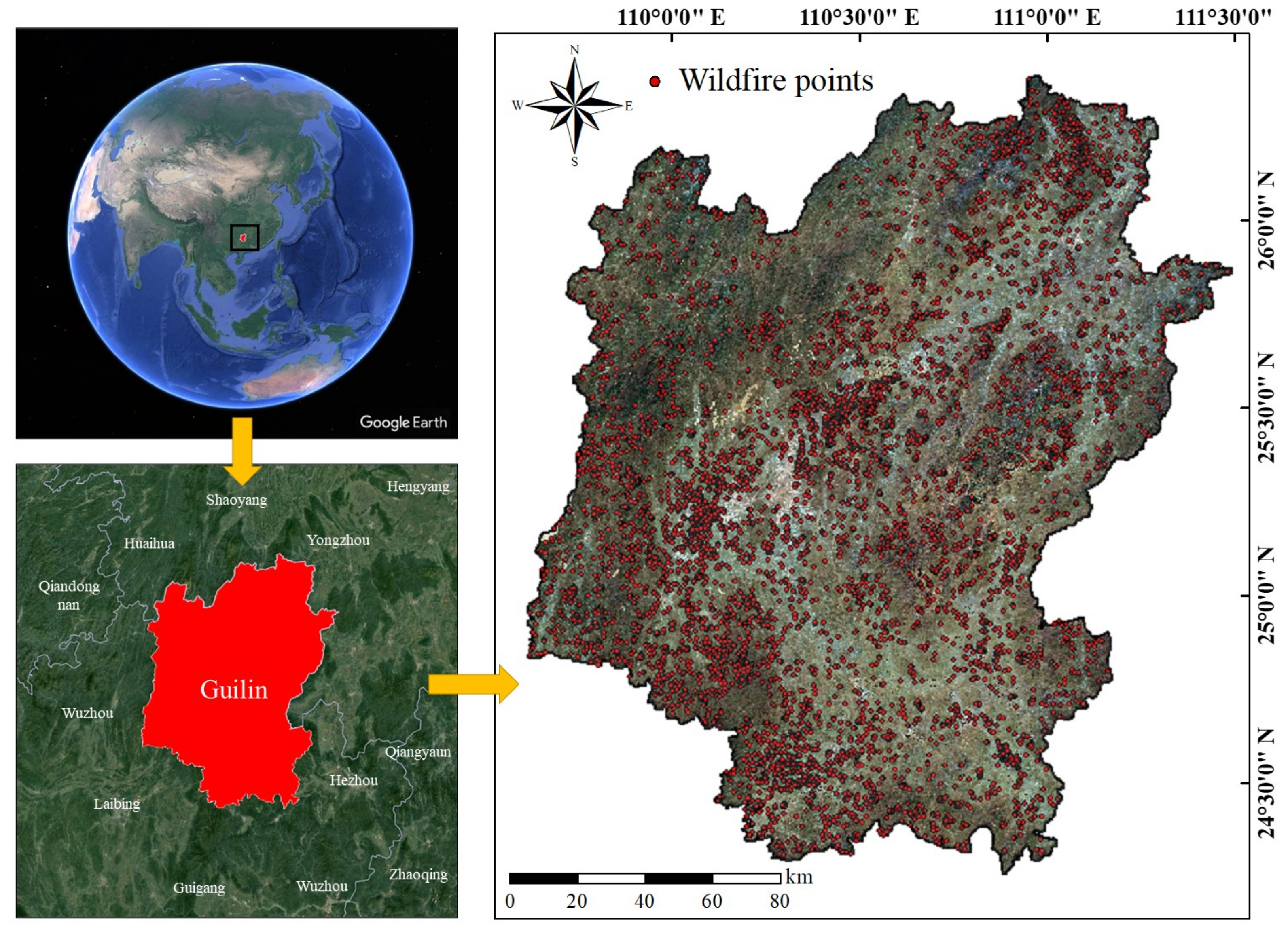

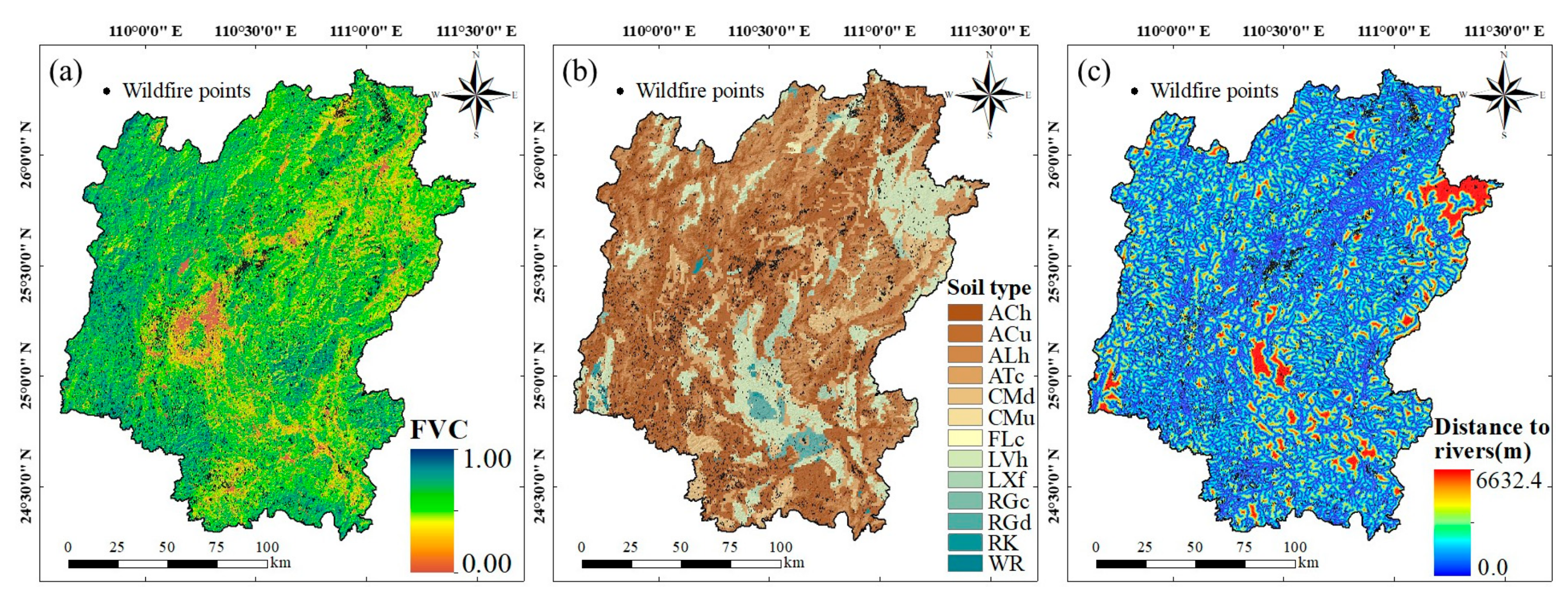
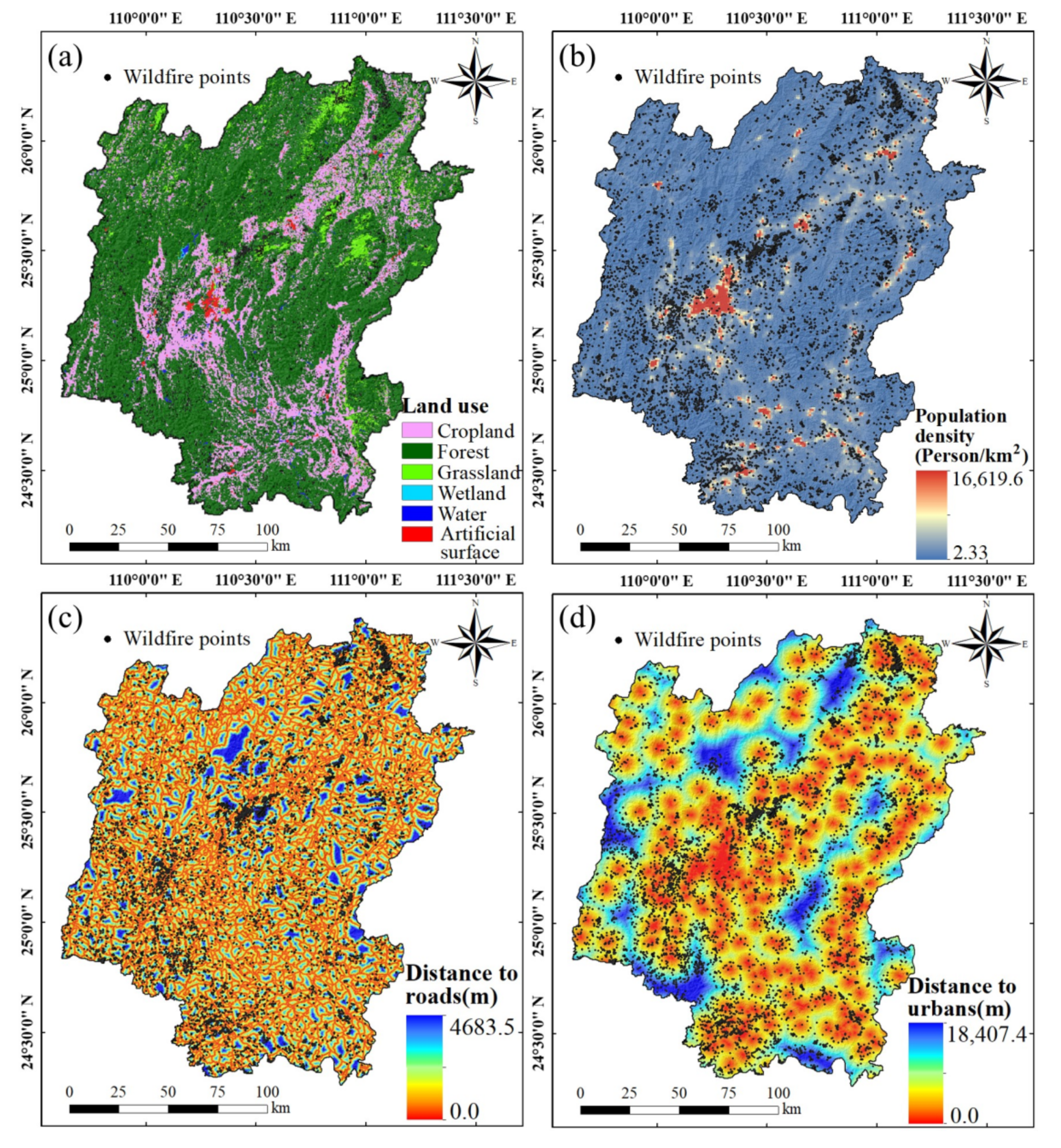
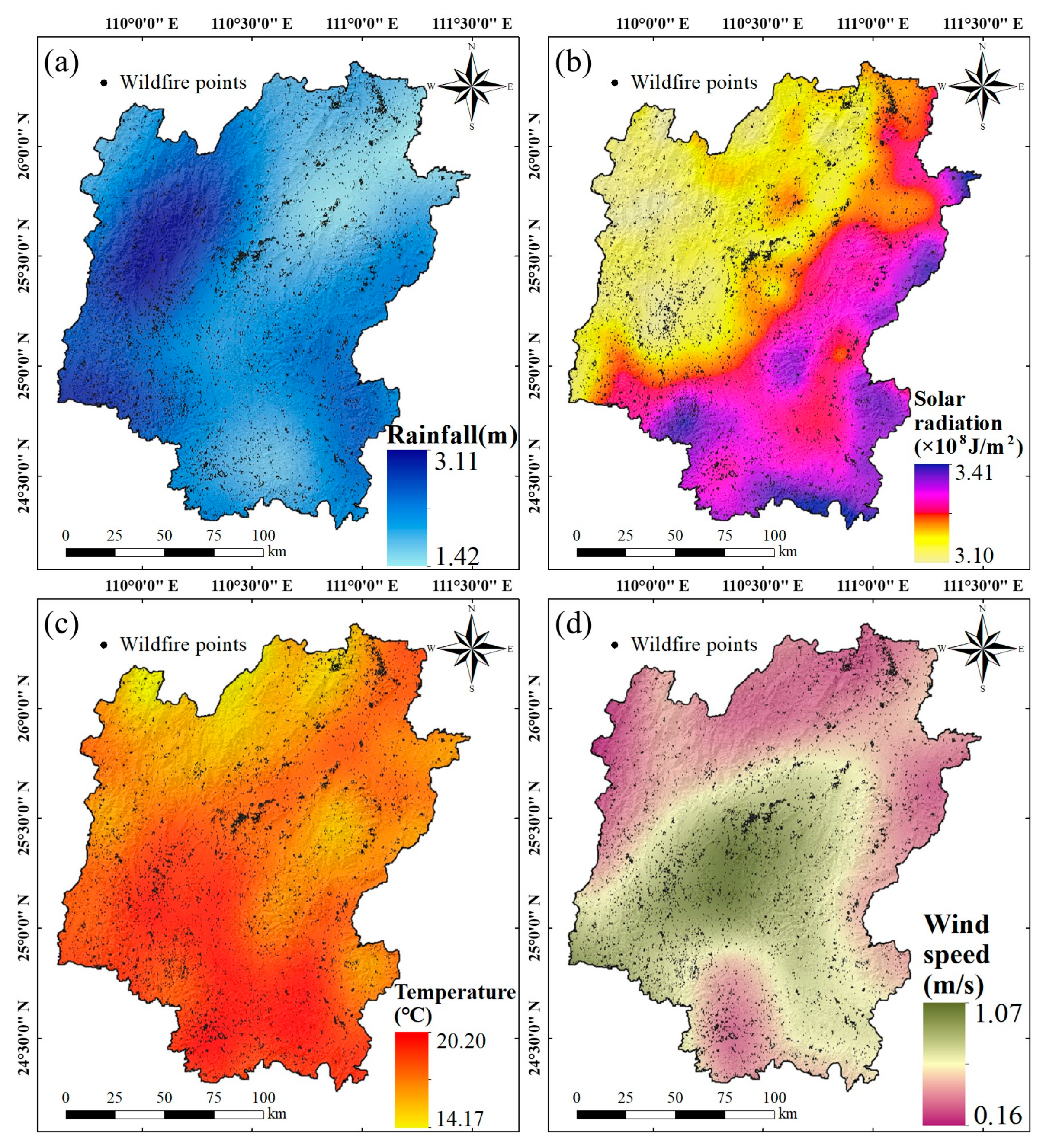
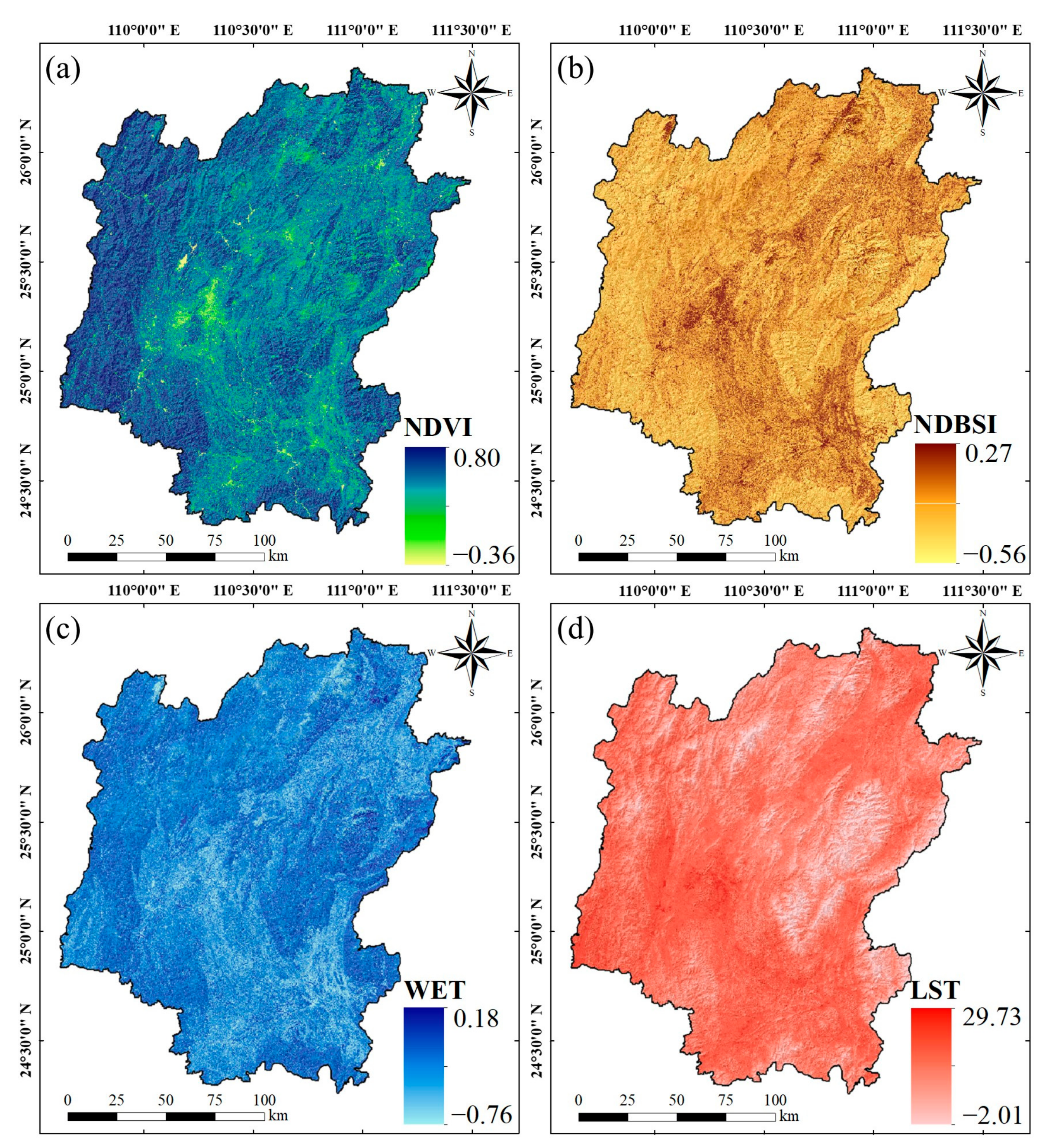
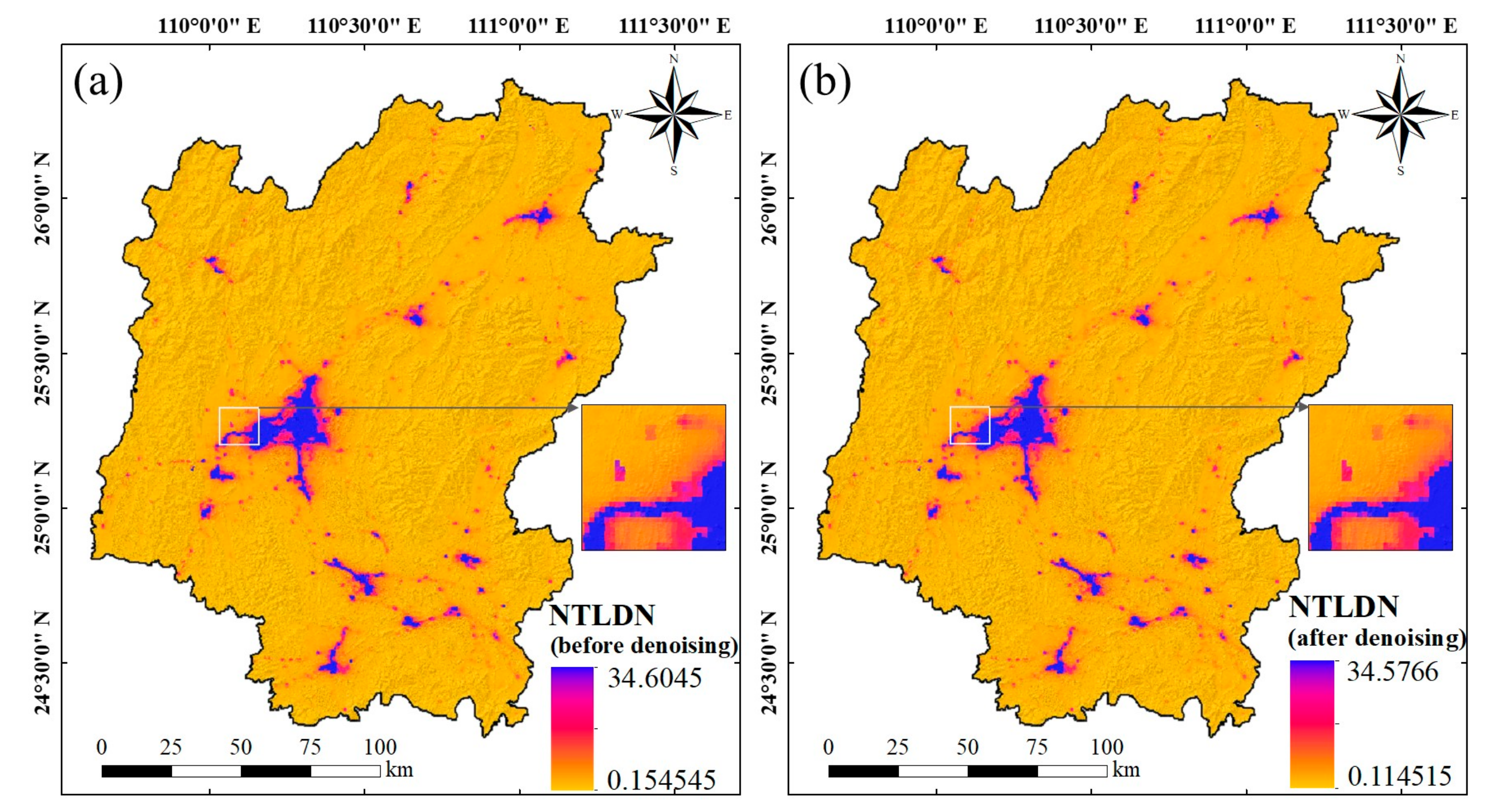

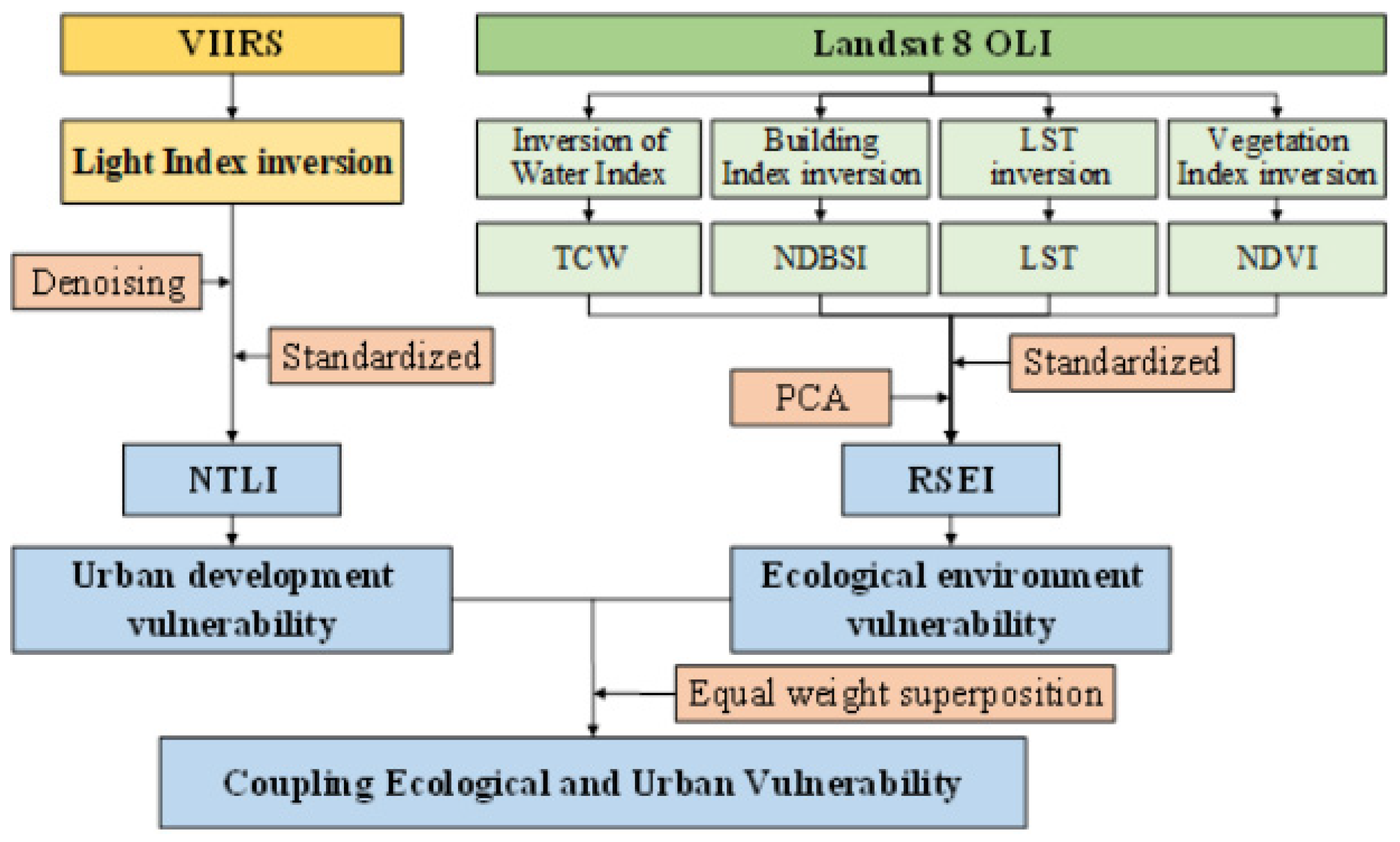


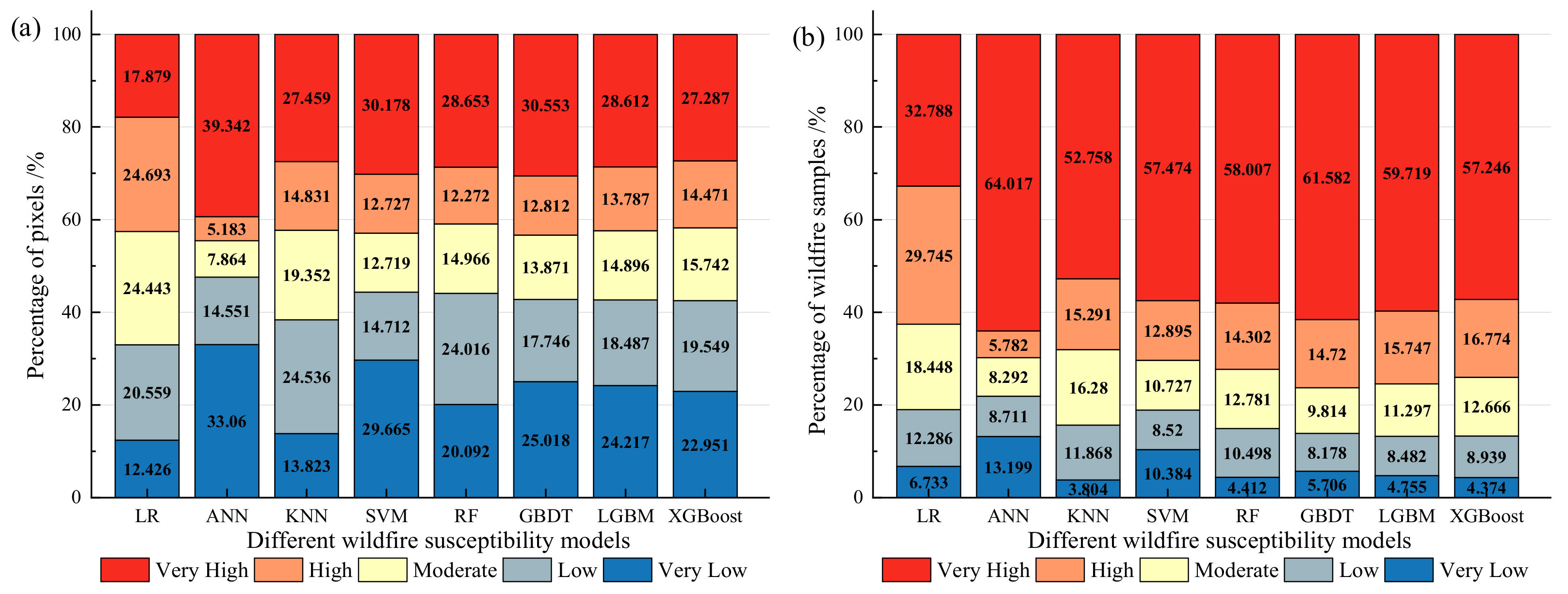
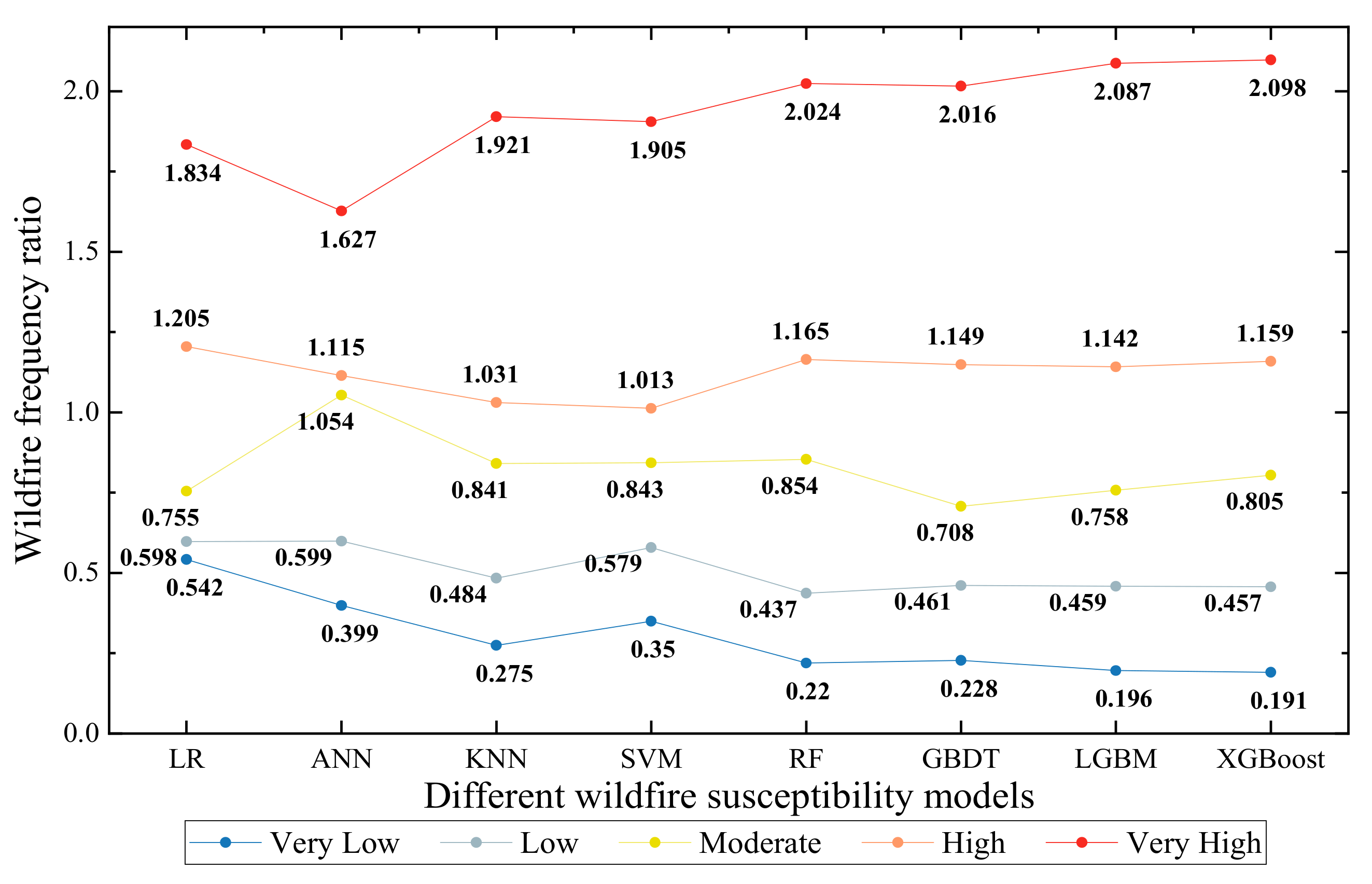

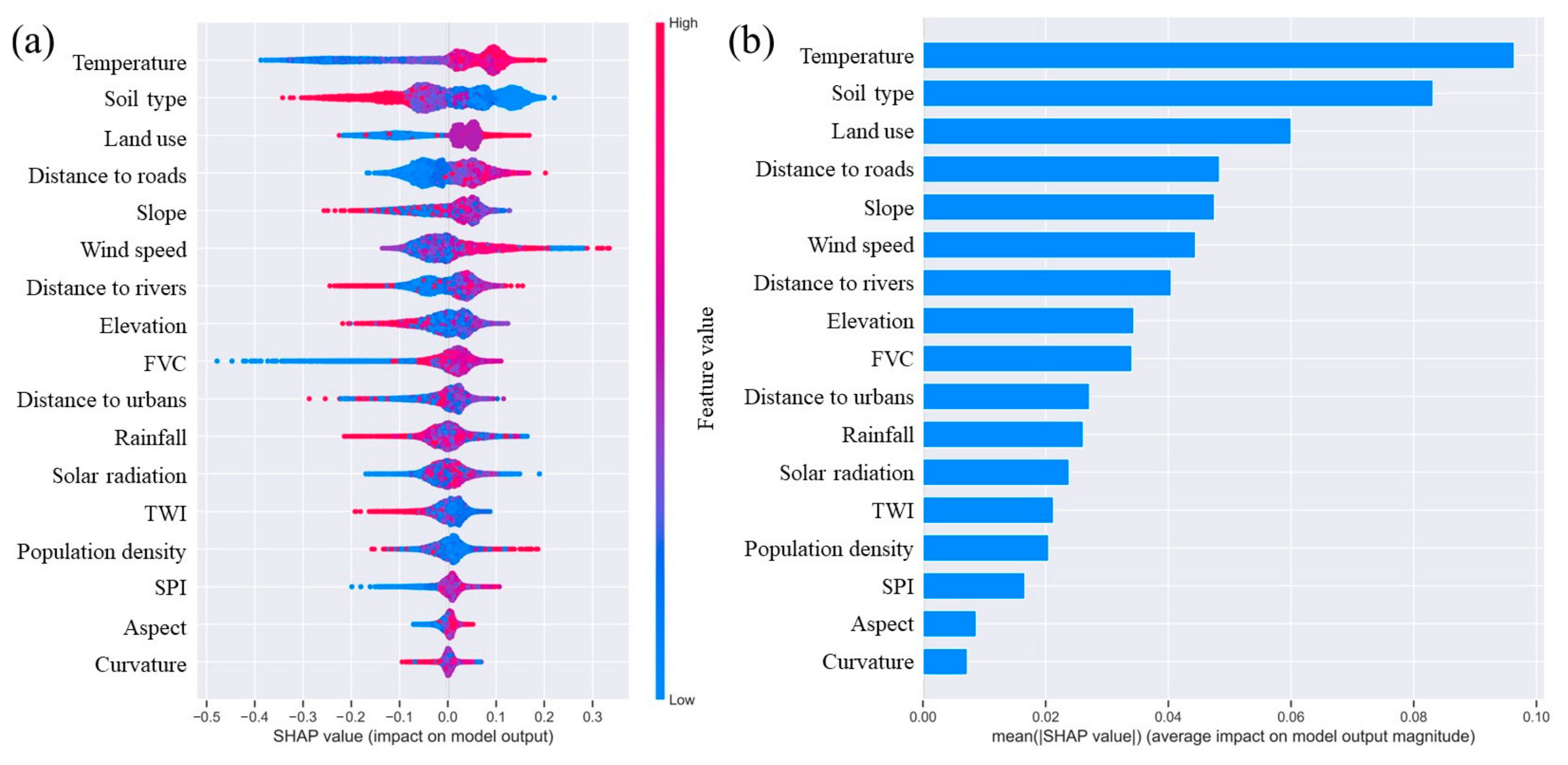
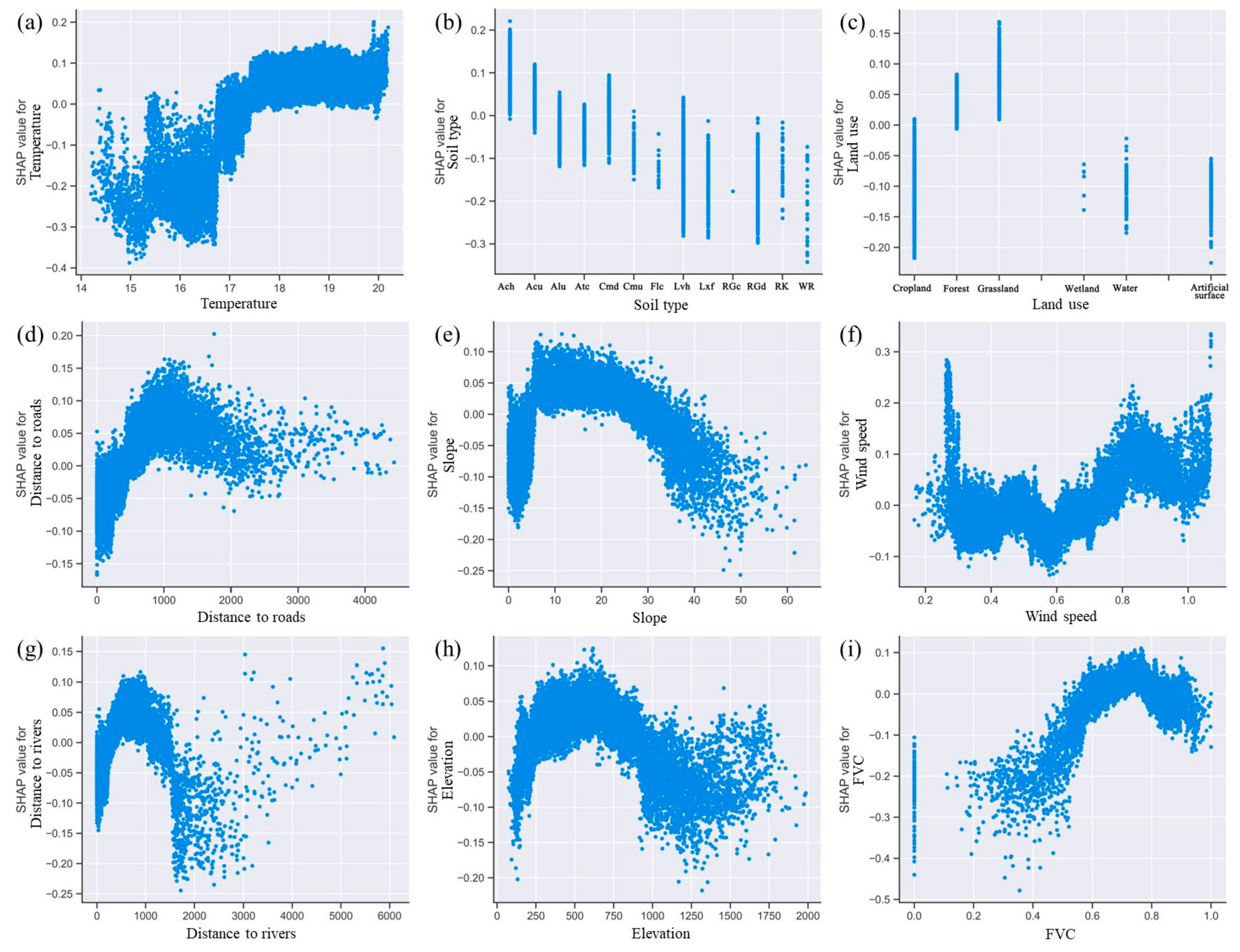
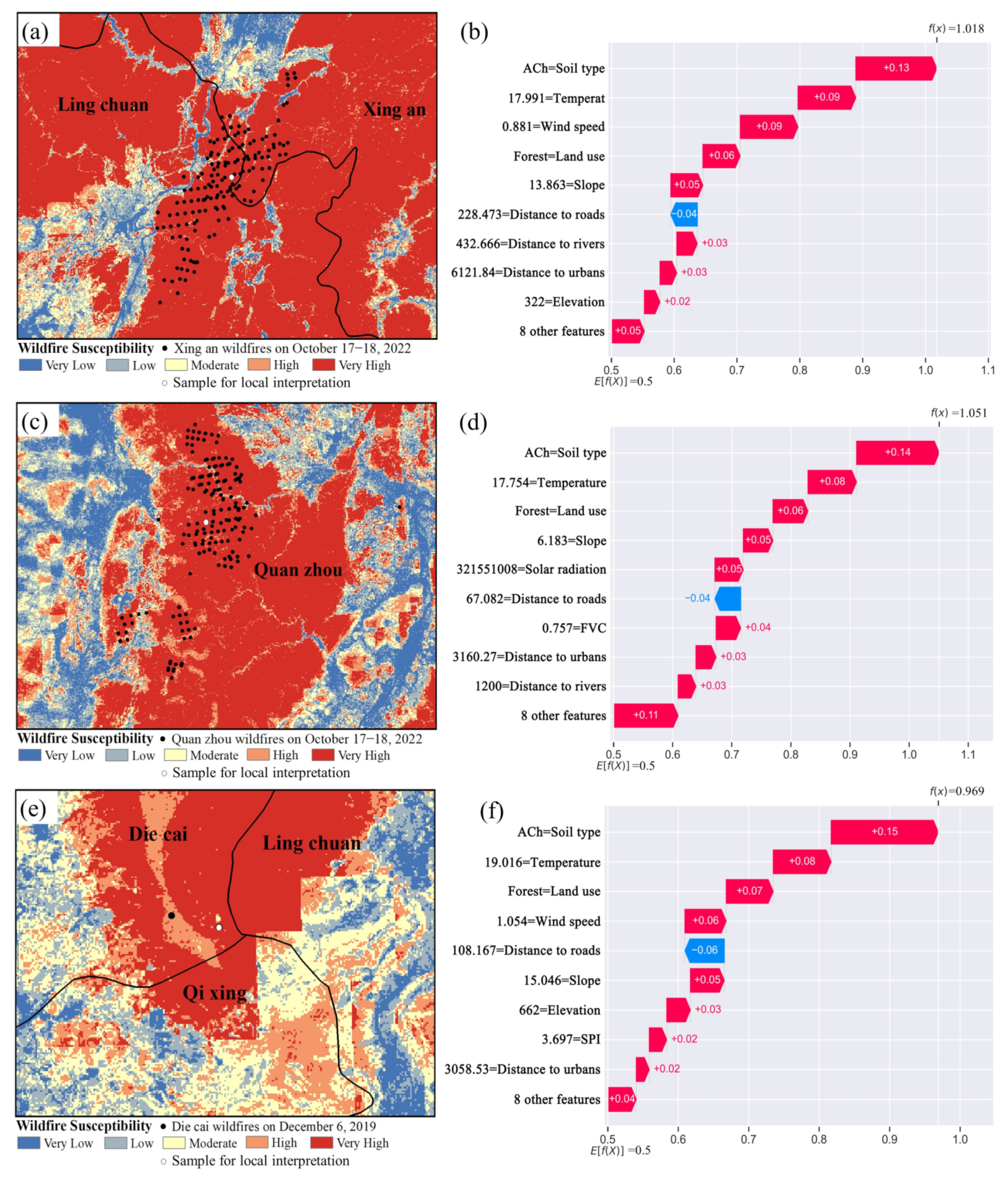

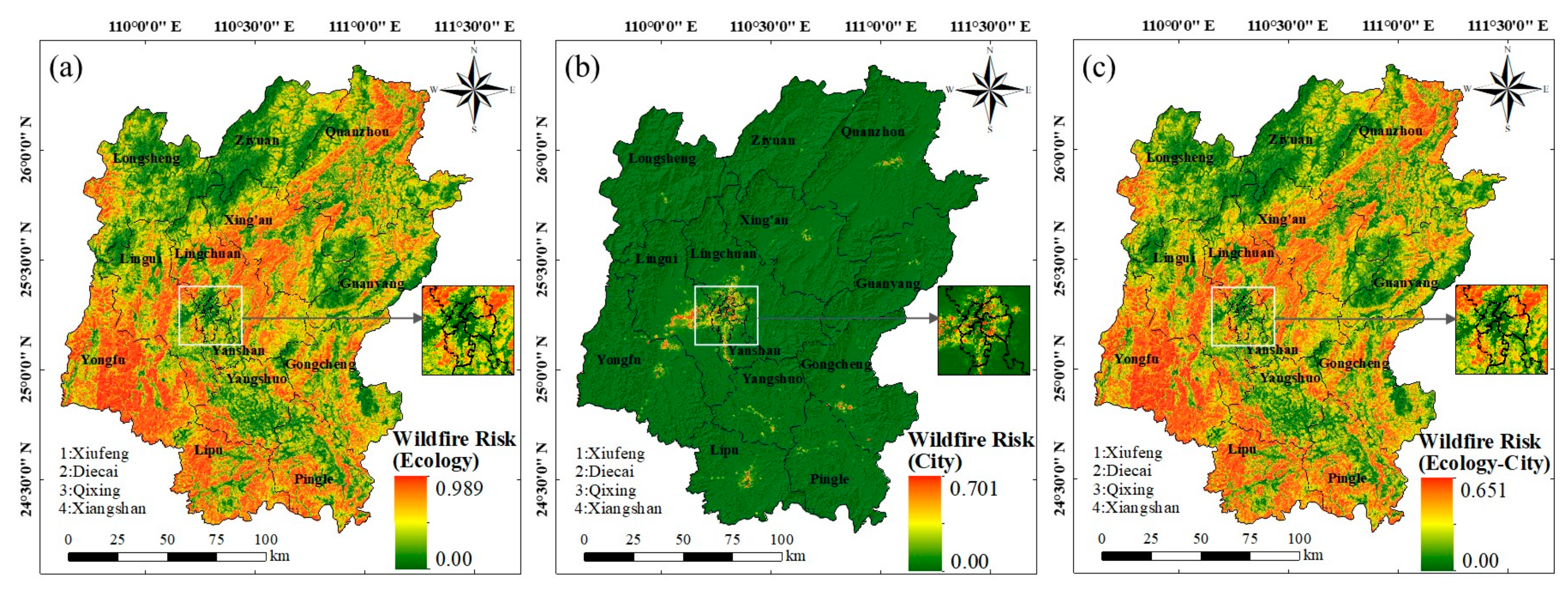
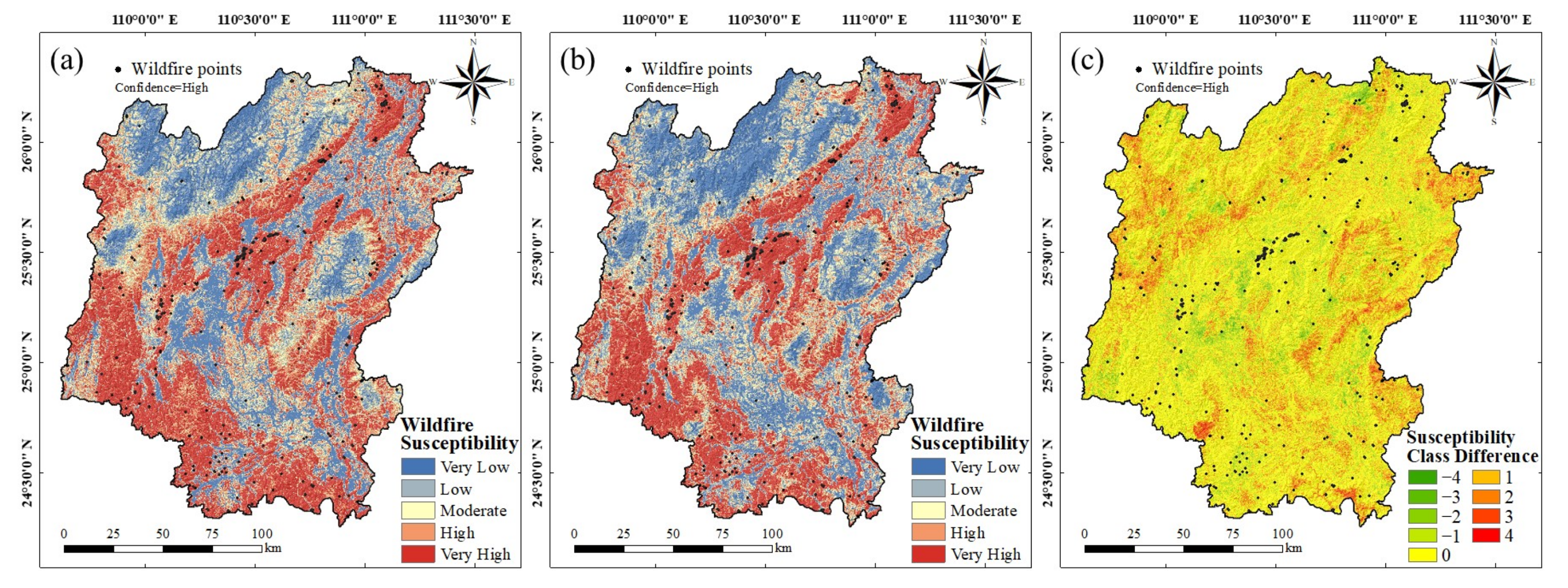
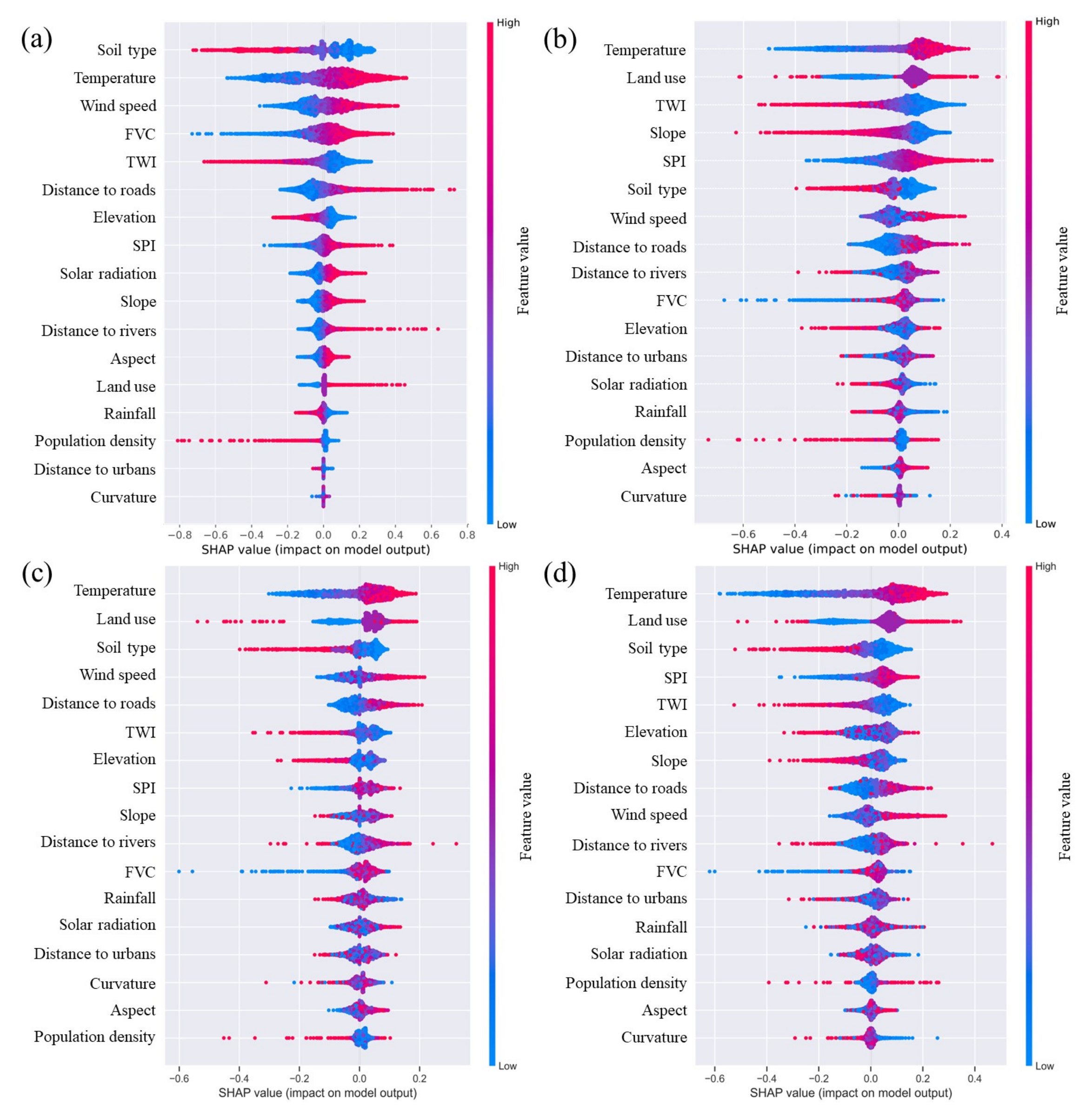

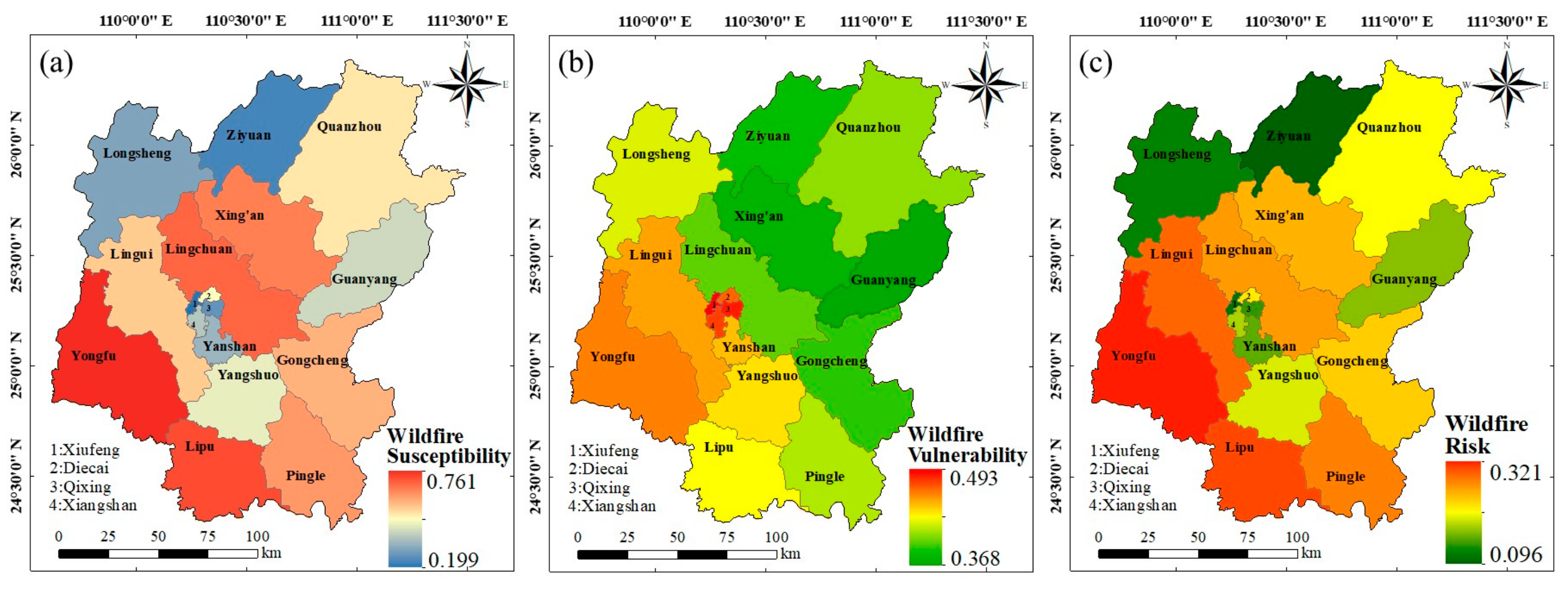
| Category | Factors | Source of Data | Format and Scale/Resolution | Data Type |
|---|---|---|---|---|
| Topographical | Elevation | SRTM DEM | 30 m (.tiff) | Numerical |
| Slope | Numerical | |||
| Aspect | Categorical | |||
| Curvature | Numerical | |||
| TWI | Numerical | |||
| SPI | Numerical | |||
| Surface environmental | FVC | Landsat 8 OLI (2013–2022) | 30 m (.tiff) | Numerical |
| Soil type | Harmonized World Soil Database (HWSD) | 5′ (.tiff) | Categorical | |
| Distance to rivers | National Catalogue Service for Geographic Information (in Chinese) | 1:250,000 (.shp) | Numerical | |
| Anthropological | Distance to roads | National Catalogue Service for Geographic Information (in Chinese) | 1:250,000 (.shp) | Numerical |
| Distance to urban areas | Numerical | |||
| Land use | GlobeLand30 V2020 data (in Chinese) | 30 m (.tiff) | Categorical | |
| Population density | WorldPop dataset | 1 km (.tiff) | Numerical | |
| Meteorological | Rainfall (surface) | ERA5-Land reanalysis dataset (2013–2022) | 11,132 m (.tiff) | Numerical |
| Solar radiation (surface) | Numerical | |||
| Temperature (2 m) | Numerical | |||
| Wind speed (10 m) | Numerical |
| Algorithm | Hyperparameters | Value |
|---|---|---|
| LR | max_iter (The maximum number of iterations) | 500 |
| ANN | units (the number of hidden layers activation) | 9 |
| “relu” and “sigmoid” | ||
| learning_rate | 0.001 | |
| KNN | n_neighbors | 15 |
| weights | “distance” | |
| SVR | kernel function | “rbf” |
| C | 4 | |
| gamma | 0.06 | |
| RF | max_features | 8 |
| n_estimators | 500 | |
| max_depth | 10 | |
| GBDT | n_estimators | 240 |
| max_depth | 9 | |
| subsample | 0.9 | |
| LGBM | n_estimators | 400 |
| max_depth | 12 | |
| num_leaves | 90 | |
| min_child_samples | 3 | |
| colsample_bytree | 0.6 | |
| XGBoost | n_estimators | 600 |
| max_depth | 10 | |
| subsample | 0.9 | |
| min_child_weight | 3 | |
| colsample_bytree | 0.6 |
| Conditioning Factor | Multicollinearity Scores | |
|---|---|---|
| TOL | VIF | |
| Elevation | 0.304 | 3.287 |
| Slope | 0.348 | 2.878 |
| Aspect | 0.987 | 1.013 |
| Curvature | 0.845 | 1.184 |
| TWI | 0.419 | 2.389 |
| SPI | 0.462 | 2.164 |
| Land use | 0.801 | 1.248 |
| Soil type | 0.900 | 1.111 |
| Population density | 0.826 | 1.211 |
| Distance to rivers | 0.909 | 1.101 |
| Distance to roads | 0.852 | 1.174 |
| Distance to urbans | 0.578 | 1.731 |
| FVC | 0.696 | 1.437 |
| Rainfall | 0.799 | 1.252 |
| Solar radiation | 0.714 | 1.400 |
| Temperature | 0.337 | 2.964 |
| Wind speed | 0.641 | 1.560 |
| Model | Sensitivity | Specificity | Precision | F1-Score | Accuracy | RMSE (All) | RMSE (1) | RMSE (0) |
|---|---|---|---|---|---|---|---|---|
| LR | 0.723 | 0.746 | 0.739 | 0.731 | 0.735 | 0.423 | 0.435 | 0.409 |
| ANN | 0.737 | 0.891 | 0.870 | 0.798 | 0.814 | 0.372 | 0.423 | 0.313 |
| KNN | 0.761 | 0.853 | 0.837 | 0.797 | 0.807 | 0.369 | 0.379 | 0.360 |
| SVM | 0.758 | 0.883 | 0.866 | 0.809 | 0.821 | 0.372 | 0.426 | 0.310 |
| RF | 0.788 | 0.917 | 0.904 | 0.842 | 0.853 | 0.335 | 0.363 | 0.305 |
| GBDT | 0.814 | 0.891 | 0.881 | 0.846 | 0.853 | 0.333 | 0.359 | 0.305 |
| LGBM | 0.818 | 0.899 | 0.890 | 0.852 | 0.859 | 0.330 | 0.358 | 0.301 |
| XGBoost | 0.818 | 0.907 | 0.898 | 0.856 | 0.863 | 0.327 | 0.356 | 0.294 |
| No. | Wildfire Disaster Site | Time | Longitude/° | Latitude/° |
|---|---|---|---|---|
| 1 | Yijia Village, Rongjiang Town, Xing’an County | 2022.10.17 Day | 110.44891 | 25.4925 |
| 2 | Baimao Village, Wenqiao Town, Quanzhou County | 2022.10.17 Day | 111.08272 | 26.19362 |
| 3 | Yaoshan, Diecai District | 2019.12.6 Night | 110.368469 | 25.303186 |
| District and County | Susceptibility Value | Susceptibility Ranking | Vulnerability Value | Vulnerability Ranking | Risk Value | Risk Ranking |
|---|---|---|---|---|---|---|
| Xiufeng | 0.199 | 17 | 0.493 | 1 | 0.098 | 16 |
| Diecai | 0.451 | 9 | 0.461 | 4 | 0.196 | 8 |
| Xiangshan | 0.377 | 12 | 0.463 | 3 | 0.171 | 11 |
| Qixing | 0.300 | 15 | 0.481 | 2 | 0.138 | 14 |
| Yanshan | 0.361 | 13 | 0.415 | 7 | 0.151 | 13 |
| Lingui | 0.521 | 7 | 0.419 | 6 | 0.219 | 3 |
| Yangshuo | 0.442 | 10 | 0.407 | 8 | 0.181 | 10 |
| Lingchuan | 0.622 | 3 | 0.386 | 13 | 0.214 | 5 |
| Quanzhou | 0.496 | 8 | 0.388 | 12 | 0.195 | 9 |
| Xing’an | 0.558 | 4 | 0.375 | 16 | 0.210 | 6 |
| Yongfu | 0.761 | 1 | 0.423 | 5 | 0.321 | 1 |
| Guanyang | 0.420 | 11 | 0.368 | 17 | 0.159 | 12 |
| Longsheng | 0.317 | 14 | 0.404 | 10 | 0.131 | 15 |
| Ziyuan | 0.250 | 16 | 0.376 | 15 | 0.096 | 17 |
| Pingle | 0.543 | 5 | 0.400 | 11 | 0.218 | 4 |
| Lipu | 0.685 | 2 | 0.406 | 9 | 0.277 | 2 |
| Gongcheng | 0.524 | 6 | 0.384 | 14 | 0.204 | 7 |
| Whole region | 0.514 | - | 0.395 | - | 0.205 | - |
Disclaimer/Publisher’s Note: The statements, opinions and data contained in all publications are solely those of the individual author(s) and contributor(s) and not of MDPI and/or the editor(s). MDPI and/or the editor(s) disclaim responsibility for any injury to people or property resulting from any ideas, methods, instructions or products referred to in the content. |
© 2023 by the authors. Licensee MDPI, Basel, Switzerland. This article is an open access article distributed under the terms and conditions of the Creative Commons Attribution (CC BY) license (https://creativecommons.org/licenses/by/4.0/).
Share and Cite
Yue, W.; Ren, C.; Liang, Y.; Liang, J.; Lin, X.; Yin, A.; Wei, Z. Assessment of Wildfire Susceptibility and Wildfire Threats to Ecological Environment and Urban Development Based on GIS and Multi-Source Data: A Case Study of Guilin, China. Remote Sens. 2023, 15, 2659. https://doi.org/10.3390/rs15102659
Yue W, Ren C, Liang Y, Liang J, Lin X, Yin A, Wei Z. Assessment of Wildfire Susceptibility and Wildfire Threats to Ecological Environment and Urban Development Based on GIS and Multi-Source Data: A Case Study of Guilin, China. Remote Sensing. 2023; 15(10):2659. https://doi.org/10.3390/rs15102659
Chicago/Turabian StyleYue, Weiting, Chao Ren, Yueji Liang, Jieyu Liang, Xiaoqi Lin, Anchao Yin, and Zhenkui Wei. 2023. "Assessment of Wildfire Susceptibility and Wildfire Threats to Ecological Environment and Urban Development Based on GIS and Multi-Source Data: A Case Study of Guilin, China" Remote Sensing 15, no. 10: 2659. https://doi.org/10.3390/rs15102659
APA StyleYue, W., Ren, C., Liang, Y., Liang, J., Lin, X., Yin, A., & Wei, Z. (2023). Assessment of Wildfire Susceptibility and Wildfire Threats to Ecological Environment and Urban Development Based on GIS and Multi-Source Data: A Case Study of Guilin, China. Remote Sensing, 15(10), 2659. https://doi.org/10.3390/rs15102659








